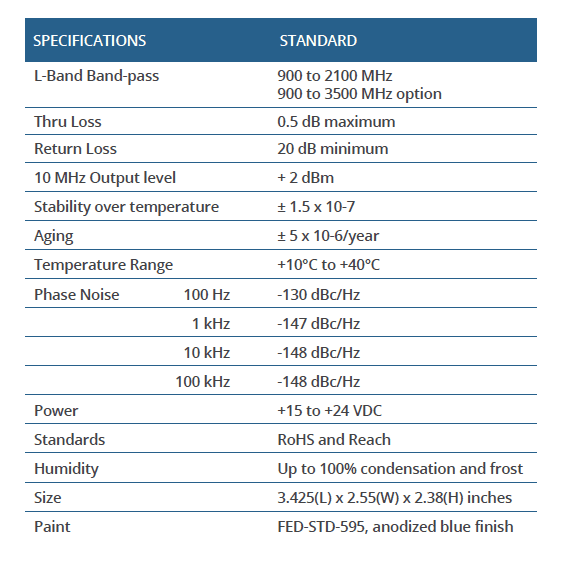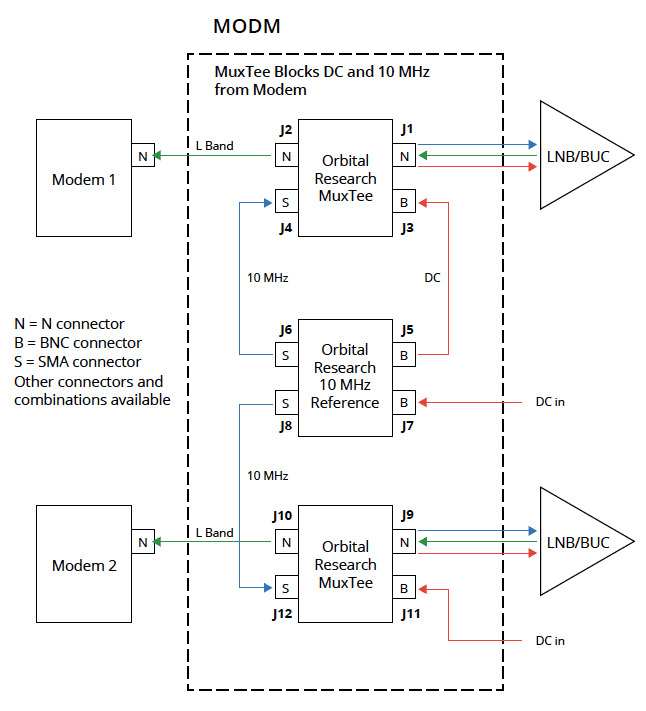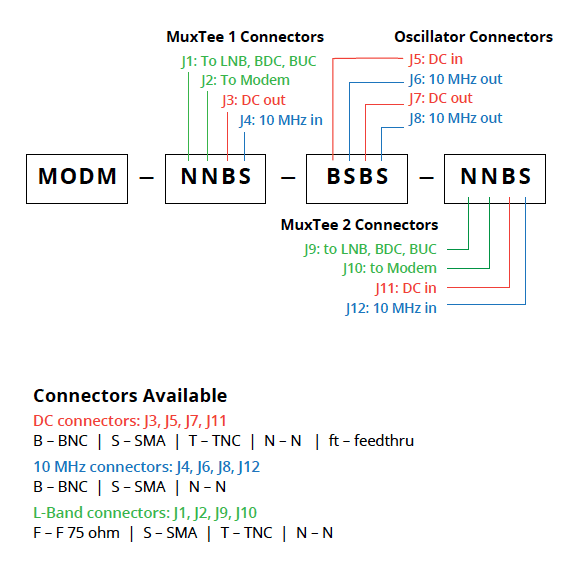MODM – Master Oscillator – Dual MuxTees
Master TCXO (temperature compensated) 10 MHz oscillator plus dual MuxTee in one package
Looking for PLL or External Reference Ku-Band LNBs? Shop Online
Click to call: 1-866-225-9366Master TCXO (temperature compensated) 10 MHz oscillator plus dual MuxTee in one package
3D Drawing (Solidworks drawing is available on request)
![]() Click to download specs & mechanical PDF
Click to download specs & mechanical PDF

Switching Power Supply
PS1 for North America
PS2 for Global
Mechanical Drawing

The Orbital MODM Oscillator has a second, feedthrough connector to allow the input DC to be fed through to one of the Mux/Tees to power the LNB or BUC attached.
An Orbital MODM 10 MHz TCXO Oscillator with Dual Modules seamlessly integrates your system and provides minimum insertion loss, maximum port to port isolation, professionally matched impedances, and gives a choice of connectors providing ease of installation. This configuration can be used to provide a 10 MHz reference and DC power insertion for a horizontal/vertical polarity system or to provide a VSAT with a common 10 MHz source for up and down links.
Another possible configuration would be with a Master Oscillator, a Mux Tee, and a 10 MHz Splitter, providing multiple 10 MHz signals for multiple devices.
Orbital Systems Interface Products are made specifically for the satellite industry, and are designed for professional and industrial quality systems. Orbital SIP products are built for rack mounting, and for use indoors or out.
| Connectors available: | Connector Part Number |
Values |
| J1, J2, J9, J10: L-Band: To LNB/BUC & Rx/Modem: | F N S |
75 Ω F 50 Ω N 50 Ω SMA |
| J3, J5, J7, J11: DC Supply | B (preferred) T N S ft |
BNC TNC N SMA feedthru |
| J4, J6, J8, J12: 10 MHz Signal | All connectors are SMA | |
| BNC-to-pigtail adapters and BNC-to-binding post adapters sold separately. See SIP price list for part number and price. | ||
Why would I want a Bias Tee Multiplexer?
Systems Interface Products Although Combiners and Oscillators are also SIP products, we have narrowed the definition here to just include Bias Tees, Diplexers, Mux Tees, TTL Switches, Thru Tees, Dual Power Tees, etc.
Here are standard applications for each of these products. Here’s how to insert 10 MHz, insert DC, extract 10 MHz, block DC, extract DC, multiplex DC L band and 10 MHz, and perform impedance transforms while you do it.
| Modem has DC power, but not enough to power my new BUC. | |
| I want to lock several modems to a single 10 MHz Oscillator, and insert high power DC to my BUC. | |
| I have a pair of modems, one of which provides a 10 MHz reference, but I don’t have enough power from my modem for my new high power BUC. | |
| I have a pair of modems and I need to use the 10 MHz reference from one of them and split it. I need to take the L-Band signal from both modems and combine it with the 10 MHz reference. Now I need to insert DC power for a pair of high power BUCS. | |
| I need to combine the L-Band signals from a pair of modems with an common, external 10 MHz source, and insert power to a pair of high power BUCs. | |
| My modem does not have sufficient DC to power my BUCs, and I can’t switch DC power to the BUC, what to do? | |
| We need a system that will provide us with both horizontal and vertical polarities at Ku Band. In addition, the system must offer 1 for 2 redundancy. |
| Using an Orbital MT-40 Mux Tee to multiplex the L-Band, and 10 MHz reference signals with DC power for a BUC. | |
| Using an Orbital MT-40 Mux Tee as a Bias Tee to insert DC Power to a BUC | |
| Using an Orbital MT-40 Mux Tee as a Diplexer to insert a 10 MHz reference to a BUC | |
| Using an Orbital Redundant Power Tee provides inexpensive power supply redundancy. | |
| Using an Orbital Thru Tee to provide a separate DC power supply to the BUC, while passing the 10 MHz signal through from the modem. |
For pricing options please call 1-604-419-8585 or contact us.
| DP1 | Diplexer – combines a 10 MHz reference signal and L-Band output into one feed to an LNB or BUC. |
| BT1 | Bias Tee – injects and filters external DC to the LNB while providing exceptional low thru loss with highpass filtering of the L-Band signal |
| RPT | Redundant Power Tee – Bias Tee with two DC inputs for redundant power supplies. |
| MT25/40 | Mux / Tee – Combines our standard Bias Tee and 10 MHz Multiplexer. |

For pricing options please call 604-419-8585 ext. 830 or contact us
Talk to an Orbital Research engineer today.